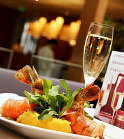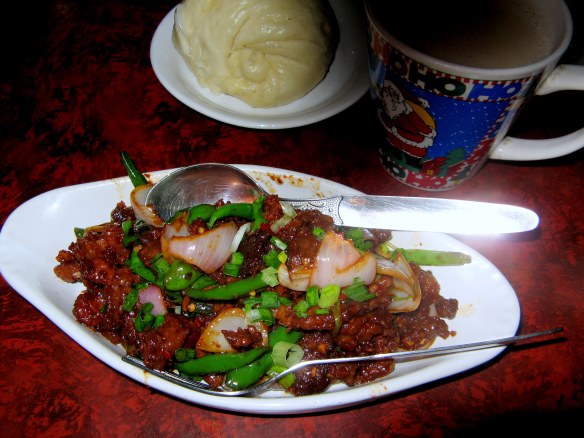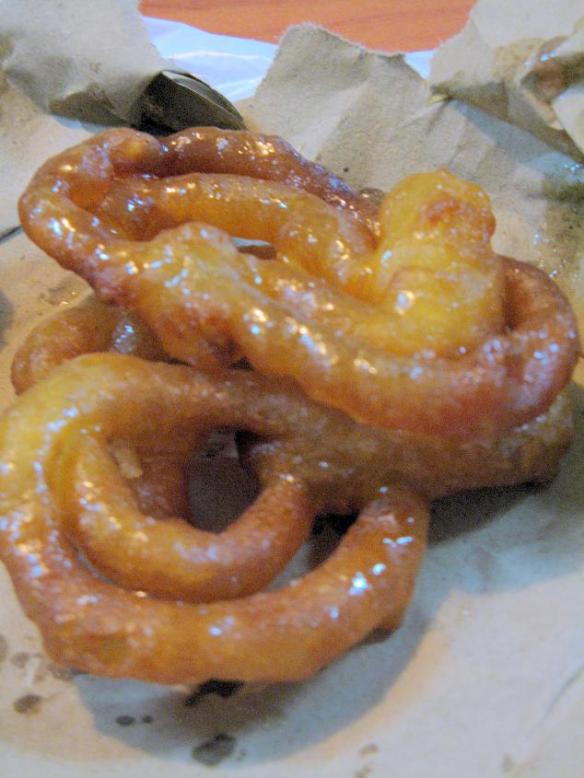About
Wonderful Korean restaurant hidden away in a back alley of Paharganj. After a while eating cheaper India food gets a little tiring, especially the limited selection which is available within walking distance of Paharganj. It was searching online for a bit of relief that I stumbled across the address for this place. Tempted by images of clean white rice, fried pork, and fresh vegetables I scrawled down the address.
It’s quite a mission to find this restaurant. You pass through another, tattered restaurant where a few ragged looking, hippy travelers are always sat around. Last time I went there, this French girl tried to sell me the sheep’s brain she had mistakenly bought from the market. Holding it out in a white plastic bag. I apologised and said I couldn’t really use it for anything. Anyway, passing through here you reach a dingy corridor, the blue paint peeling off the walls like the bark a silver birch, the floor coated with dust, and tools and junk stacked up in piles. Climb up the ragged, half lit staircase, passing the open doors of rooms with beds unmade, their TV’s flickering and Indian’s staring out with weary eyes. Then at the top , through all this drabness, is the bright haven of the restaurant.
In an article for Lonely Planet’s blog, the Dehliwalla describes this place as ‘a smuggler’s den’ full of the ‘fetid air’ of the street and ‘hostile eyes’. Either he went somewhere different, or the restaurant has seriously changed since then, because I found it a really calming and comfortable place to go to escape from Paharganj’s bustle. It was great to watch of exhuberant sociability of the big groups of Korean’s always gathered there as they drank bottle after bottle of Korean wine, toasting each other loudly and laughing and joking. The boy who always served me was efficient and friendly.
He and two other boys appeared to cook all the food as well. There is a neatness to Korean cooking, an attention to the way something is sliced or prepared, which is very different to Indian food. The Korean’s seem to share with the Japanese an interest in using very simple ingredients almost in their pure form to give subtle flavours. Its often the pairing of different things that is important – the crisp cool cabbage and the chilli sauce of Kimchee for example. Eating the food here, I sense the pride Koreans take in their food, the exacting standards they apply to it even when abroad.
Food
The dishes at Dokebi Nara made a fair attempt at being authentic and were a refreshing change from the pseudo-Chinese or Japanese food a lot of places try to pass off. I’ve had a bit of Korean food in Hong Kong and tend to compare what I eat elsewhere to that experience. The Korean at Dokebi Nara wasn’t quite as good, in terms of ingredients or preparation, but it wasn’t hugely dissapointing either.
The ‘bibimbap’ – meaning stirred or mixed dish – came in a large bowl with really generous piles of pleasingly fresh tasting vegetables around the sides of rice that had just been made and didn’t taste dried out at all. Rather than just carrot and cucumber, the dish had mushrooms and other more specialised korean vegetables which added to the sense of authenticity. When mixed together with the rice and sauce, the dish here felt nicely balanced.
The sauce was basically just very rich tomato paste, whereas I think other places probably use something more subtle. Swati, friend of Eating Out in Delhi blog, corrected me on this, stating that” the disturbing part about the first review is that they described the sauce for the bibimbap at Dokebi Nara as a tomato based sauce. I really, really hope that this is a mistake by the blogger, because I cannot imagine a Korean committing the blasphemy of serving a tomato based sauce for the bibimbap. The sauce served with bibimbap is based on gochujang, which is a paste made mostly with crushed red peppers rice powder (or wheat or barley) and fermented soyabean paste. For making the sauce, this gochujang is thinned with vinegar, and sugar, sesame seeds and sesame oil are added.”
It should be noted that I wrote this review a considerable time after visiting the restaurant and my memory may not have held too well. However, the sauce I tasted, expecially once mixed into the dishes other ingredient, really had little to distinguish it in my mind from a tomato paste. I couldn’t taste the red peppers, or the bean paste. This is perhaps a mark of the overall quality of the food on offer at Dokebi Nara – and would be picked up by people more attuned to Korean food immediately, or perhaps it is just as sign of the fact that I’m a layman to this type of cuisine. However, I stand by my original comment that the sauce ‘did well enough to make the dish quite satistfying’.
The boiled down pork dish is also good, with very succulent pieces of pork sunk in a quite gloopy and slighly sweet tasting sauce. It’s hard to say how authentic this sauce is because I haven’t had anything that similar elsewhere, but the sweetness of the sauce has much more balance than that in many poorly done Chinese sweet and sour dishes. This is a real comfort dish to eat – with the fluffy white rice soaking up the meat juice and the sauce and holding its flavours nicely.
The spicy korean noodles were a bit dissapointing. It had the right clear noodles, which have a really good cool, smooth texture which contrasts with the fieryness of the broth. But the problem here was that while the broth was seriously spicy from the chili oil used, it was also very watery and didn’t have any other flavours to balance this spice. The result was just an overwhelming chili taste that wasn’t that pleasant. A few bits of egg floated around in the broth, but these didn’t contribute much at all.
As is typical in Korean dishes, these dishes came with a whole array of side dishes spread accross the table. The kim chi was really good, with cool fresh cabbage given a good fiery kick by the red sauce which stained it. All these side dishes, whilst not that remarkable in themselves, added to the overally experience. The restaurant is also one of the few places in Paharganj to serve beer, at R60 for a small can. This definitely goes with the food well and makes it a good place to come to chill for a while.
I’m yet to try the ‘liquor dishes’ – the meats cooked on a hot plate which are a vital part of Korean cusine. These are relatively quite expensive, presumeably because of the extra work involved setting up the hot plate and things. But watching the other Korean groups have them, and the Korean sushi, I would say that both are likely to be really enjoyable.
Second Opinion – Hemanshu, author of Eating Out in Delhi, wrote the following about the food at Dokebi Nara
“I must admit upfront that the sum total of my prior experience of Korean food is from one EOiD trip to “Gung” in Green Park and one to Soo Ra Sang in Bangalore. The cost of our meal at Dokebi Nara worked out to less than Rs. 300 per head. That puts it at about half what a meal at Soo Ra Sang would cost and perhaps 1/4th to 1/5th of what you pay at Gung.
However, from this first visit to Dokebi Nara, I would put the taste also at a fraction of what you can enjoy at the other two places. The menu itself is very limited, as are the linguistic abilities of the owner. As a result, while I had every intention of ordering a beef dish, I didn’t even end up finding out if they serve beef, let alone ordering a beef dish. Their ability to serve a full restaurant is also seriously lacking — there was a group of about a dozen foreigners at a table behind us, and thanks to that, we were served a good one hour after we placed the order (no kidding!). We ordered the bibimbap, which was served as a vegetarian dish (not counting the fried egg), some kimchi soup, a pork dish from their “liquor foods” list, an egg-roll, and some “soju”, or Korean wine. None of it left much of an impression, though the pork was not bad. The rest were bland, perhaps to some extent because we asked for them to be “medium spicy”. The side-dishes, unlimited in true Korean tradition, were few in variety and uninspiring, comprising spiced-up cabbage, potatoes, seaweed and (I think) radish.”
Directions
About halfway down its lenght Paharganj’s Main Bazaar opens out into a triangular space. Walk along Main Bazaar to the end of this open space furthest from the railway station, on one side are men selling pakoras and on the other people frying the twisted jalebi sweet in woks. Turn down the alley that is just to the station side of the jalebi sellers. Walk down narrow alley, when you get to a small square turn hard left, and you should come to the Navrang Guesthouse. Don’t confuse the downstairs restaurant which also sells some (bad) japanese food. Go through reception and up stairs to second floor. There are little painted figures on the walls to guide you.
Address: Navrang Guesthouse, Paharganj. Θ Ramakrishna Mission or New Delhi Railway Station. Ask for “6 – Chhe – Tooti Gali”.
Cost
The main dishes like bibombop cost around R 150-180. The barbeque ‘liquor dishes’ cost about R 300-400. Beer is R 60 for a small can of Kingfisher.
Notes
For more on Korean food in Delhi click here.




























